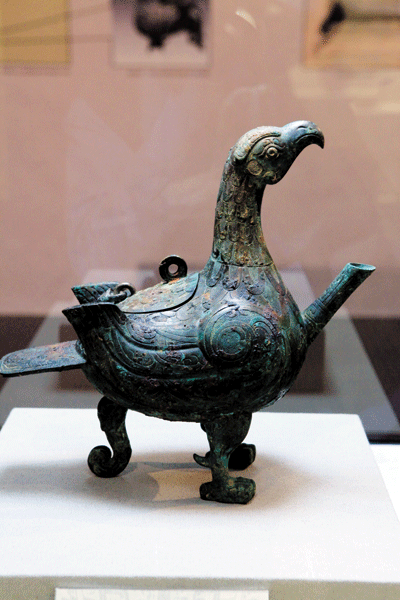 Cao Zhen caozhen0806@126.com SHENZHEN Museum is exhibiting more than 180 pieces of bronzeware, goldware and porcelains dating back more than 3,000 years from North China’s Shanxi Province, tracing the culture of an almost unknown ancient state. The relics were discovered between 2007 and 2010 in the Dahekou Tombs in Yicheng County in northern Shanxi Province. A large number of bronzewares, pottery and primal porcelain have been found among the 615 tombs that cover an area of over 15,000 square meters. The inscriptions on the bronzeware led archaeologists to the owners of the tombs, two counts of the State of Ba (霸国), a vassal state of the Western Zhou Dynasty (1046-771 B.C.). Count was the third rank of the five peerage imperial ranks (duke 公, marquis 侯, count 伯, viscount 子, baron 男) in the Zhou Dynasty. Only the Zhou ruler bore the title of king (王) and the kings made hereditary land grants to various relatives and descendants. Of the hundreds of states, some were little more than a small fortified town or city while others possessed a capital as well as other urban areas and controlled significant amounts of territory. Although each state bore the suffix “state” (国), they were not nation-states. The State of Ba was not historically significant and has no record in historical archives, so its domain, area and exact existence period are unknown yet. The Zhou Dynasty produced what many consider the zenith of Chinese bronzeware making and the exhibition showcases a broad range of ritual food and drink vessels inscribed with archaic and animals. Weapons and percussion instruments, pottery and jade accessories, as well as goldwares, have given evidence of the abundant wealth of the courts of Ba. All of the burials in the Dahekou Tombs were vertical shaft pit tombs in rectangular layout, most of which had waist pits containing dogs, some of which even had recesses in the walls. According to Qiao Wenjie, an ancient art researcher at the Shenzhen Museum, the excavation of the tombs is significantly meaningful for the research on the enfeoffment system and ritual vessel-using. More mysteries might be unveiled as some tombs are still under excavated. Dates: Until March 6, 2016 Hours: 10 a.m.-6 p.m. Closed Mondays Venue: Shenzhen Museum, Block A, Civic Center, Futian District (福田区市民中心A区深圳博物馆新馆) Metro: Shekou or Longhua Line, Civic Center Station (市民中心站), Exit B | 
